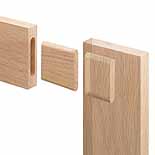I'm not necessarily looking for the fastest way to do this. I'm looking for the best way I can do it with my experience and my currently owned tools. I am probably being stubborn, but I'll probably go with my existing plan and mess around with some scraps to learn how to make the loose tenons.
NCReefer (it'd be good to update your profile with a first name, btw)-
I'm going to suggest that you not go the loose tenon route in just this one particular instance. Because a headboard is subject to a lot of racking forces, you'll be depending solely on the glue in both mortises to hold everything tight, though it's possible you could pin both sides of the joint.
Instead, and with the tools you already have, I'm going to suggest that you make a traditional tenon on the ends of the rails, and a mortise in the legs. Your router and a couple of bits are all you need to do this, though you will either have to have a fence made for your router, or build a little auxillary base jig.
If you've a fence for your router, you can clamp both rails together on the bench, and set the fence so that you cut a clean shoulder on both sides of the rails - the outside material still left will allow your router something to ride on. Once that's done, you can clamp about a 4" wide board to the top surface of the two rails (the router base will ride on this), reset your fence and depth of cut, and use the router to remove the outer material on the rails (the router will ride on the clamped board, with the fence running on the rail side of the board). Presto - two tenons cut perfectly on your rails. You then just flip the rails and repeat the procedure. You will then have to decide whether you want an edge shoulder. If so, I would use the table saw and a miter gauge to do the Norm thing and make the shoulder cut, then "nibble away" the rest of the material.
For the mortise, you can use the router fence and a couple of stop blocks (just a couple of pieces of scrap clamped to the leg will do) to cut a mortise in a few passes. If you don't have a fence, you can make an auxillary base for your router out of 1/4" plywood in which you've mounted two downward-facing dowels on either side of the bit (as widely spaced as the auxillary router base will allow). One then simply seats these two dowels on opposite sides of the leg, and the router bit will automatically be centered on the stock.
I described this a bit backwards, by the way - it's usually best to cut your mortises first, and your tenons second (to fit the mortises).
By the way - on a bed, I always pin these joints by drilling through the back of the leg into and through the seated and glued tenon, then driving a dowel (with glue) into the joint. Then, even if the glue fails, the joint cannot come apart.






